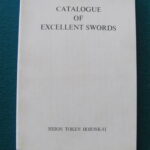Q828. Osuriage Tachi Tokubetsu Hozon to Nakajima Rai, Higo Koshirae
$12,500.00
Q828. Osuriage mumei tachi with Higo Koshirae, attributed to Nakajima Rai.
Nagasa: 27 1/4″ 69.1 cm.
Sori: 1.3 cm.
Moto haba: 2.8 cm.
Moto kasane: .5 cm.
Saki haba: 2.2 cm.
Saki kasane: .3 cm.
Nakago nagasa: 8 1/4″ 17.2 cm.
Overall in shirasaya: 38″ 96.5 cm.
Shinogi zukuri, iore mune, chu kissaki.
Horimono: futasuji hi on each side.
The hada is the finest small itame with mokume and masame elements, all in chikei (ji nie): so lovely. The hamon is a medium to wide suguba with lots of subtle hataraki and a clear, sharp line of ko-nie – quite nice. The boshi is a continuation of the hamon, ending in ko-maru with a short kaeri. The blade is mounted with a copper habaki and in well made shirasaya with an unsigned sayagaki, giving the sword to “Nakajima Rai, mumei”. The sword is in exceptional polish and is flawless.
The Higo koshirae is mounted with a full length tsunagi (wood blade). The saya is ribbed black lacquer with horn kurikata and koi guchi; I see no damage to the lacquer. The kojiri, fuchi, and kashira are ensuite: iron with gold. The sageo is leather, something I don’t recall having seen before. There is a sleeve in the saya where you would expect a kotsuka/kogatana but instead there is a small, polished umabari. Umabari were used to bleed horses. After a long, hard ride blood would pool in the lower legs and the umabari was used to relieve the pressure. The tsuba is iron with either gold or brass, silver, and shakudo inlay; it was made for this koshirae as the small ryo-hitsu fits the umabari perfectly. The menuki are shakudo with gold and the handle wrap is suede. Excellent koshirae in excellent condition.
This tachi comes with a Tokubetsu Hozon paper from the NBTHK, dated 2009 and giving it to Mumei, Nakajima Rai. There is also a paper from the JTK (I’m not familiar with this group), dated 2008 and giving the tachi to Rai Kuninaga, Gentoku era (1329).
First generation Kuninaga is thought to have been active around 1326 (end of Kamakura) and to have been a student of Rai Kunisuye, who was a student of Rai Kunitoshi. At some point in his career, Kuninaga moved from Kyoto to Settsu, settling in an area called Nakajima. His work and that of the 2nd generation Kuninaga are called Nakajima Rai
A beautiful blade, fine koshirae, great condition throughout: what’s not to love. This should move quick. 4 pounds, 3 ounces. $12,500.





































































































































